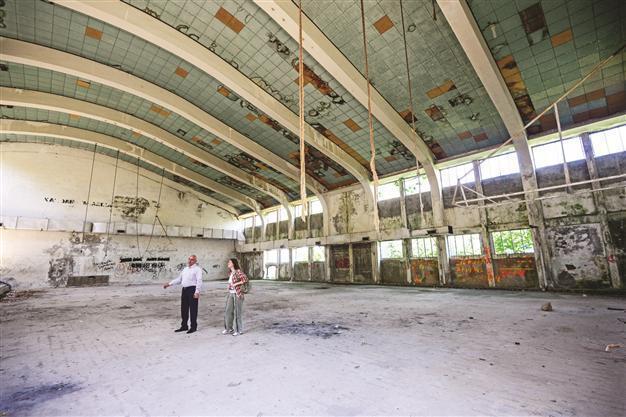Infamous Yassıada island 'should host Democracy Museum'
ISTANBUL - Hürriyet Daily News

The court where former Prime Minister Menderes was tried and sentenced to death on Yassıada Island has fallen into decay. DAILY NEWS photo/ Emrah GÜREL
The Mayor of Istanbul’s Prince Islands has reacted against a government plan to zone the Yassıada and Sivriada islands, which hold both archaeological and political importance for Turkey, for tourism and housing, amid calls to turn the islands into a “Democracy Museum.”
Mostly remembered for being the places of exile of former Prime Minister Adnan Menderes, Yassıada and Sivriada, which are two of the seven islands that constitute the Prince Islands lying in the Marmara Sea, will be allowed to have hotels, restaurants, religious spaces, conference and congress centers built, according to a recent law amendment.
Prince Islands Mayor Mustafa Farsakoğlu told the Hürriyet Daily News that both of the islands needed to be preserved as they contained archaeologically important ruins dating back to archaic ages and the times of the Byzantine and Ottoman empires. Yassıada was also the place where former Prime Minister Adnan Menderes underwent a trial that convicted him to life imprisonment.
“We have asked for archaeological excavations here, we wanted [Yassıada] to be turned into an open air museum,” said Farsakoğlu, reminding that before the 2011 general elections Prime Minister Recep Tayyip Erdoğan had mentioned the possibility of a museum for democracy being built on the island. He said that ex-Culture Minister Ertuğrul Günay and Istanbul Mayor Kadir Topbaş had been to Yassıada to carry out examinations, adding that they were not waiting for a decision for the zoning of the island.
Yassıada is known for being the exile island of former Democrat Party leader and former Turkish prime minister Adnan Menderes, and other party members following the 1960 military coup in Turkey. The trials of the party members were also held on the island. The tribunals ended with the execution of Menderes, Minister of Foreign Affairs Fatin Rüştü Zorlu and Minister of Finance Hasan Polatkan on İmralı island on Sept. 16, 1961.
In a visit to Yassıada in 2011, Istanbul Mayor Kadir Topbaş, Governor Hüseyin Avni Mutlu and then Minister of Culture and Tourism Ertuğrul Günay announced that a “democracy museum” would be built on the island, but did not mention hotels or restaurants.
The island was listed as “under protection” as a historical and natural area in 1976. With a change in 2011, the island’s rights were handed over from the Treasury to the Culture and Tourism Ministry. Another change in 2012 saw the island’s status opened to “controlled use.”
Hüsamettin Cindoruk, a veteran politician, who defended Menderes as a lawyer in 1960, told daily Hürriyet that the island should be kept as a “democracy museum.”
“I strongly object to turning an island, where so much pain has been suffered, into a tourism or residence area as if nothing had happened,” he told Hürriyet. “I would like it to be used as a democracy museum.”
'We don’t want another Gezi Park incident'
Mayor Farsakoğlu said that though they did not want a new Gezi Park incident, the project needed to be debated among the groups who differed on the subject. “This project should be discussed; views from every segment should be taken. Even a referendum should be held,” said the mayor, adding that a project to open the islands to automobile traffic by joining the islands to the mainland with a bridge had been put forth. “All these projects will cause irreversible damage to the islands,” said Farsakoğlu.
Yassıada lies in ruins with its only inhabitants – two German shepherd dogs – and bushes as tall as humans, while the building where the trial of Adnan Menderes took place is being destroyed by humidity, according to observations made during the Daily News’s trip to Yassıada together with Mayor Farsakoğlu after special permission was given.
Ruins of dungeons, prison cells and castles from the Byzantine time lay on the island, unprotected from the “island pirates,” as Farsakoğlu calls the treasure hunters. It is as though an ancient piece could be unearthed were you to dig slightly.
The enormous hall, where the court took place in the early 1960s, was later used as a sports hall, which can be understood from the pipes and ropes hanging down from all over the building.
This building is really important for the history of the Turkish Republic and the history of democracy. No damages should be incurred to either the nature or the history of the island. This is an issue above any political party,” said Farsakoğlu, while sitting on the wrecked benches of the former court hall. He added he could not conceive of how the islands could be zoned for housing.
